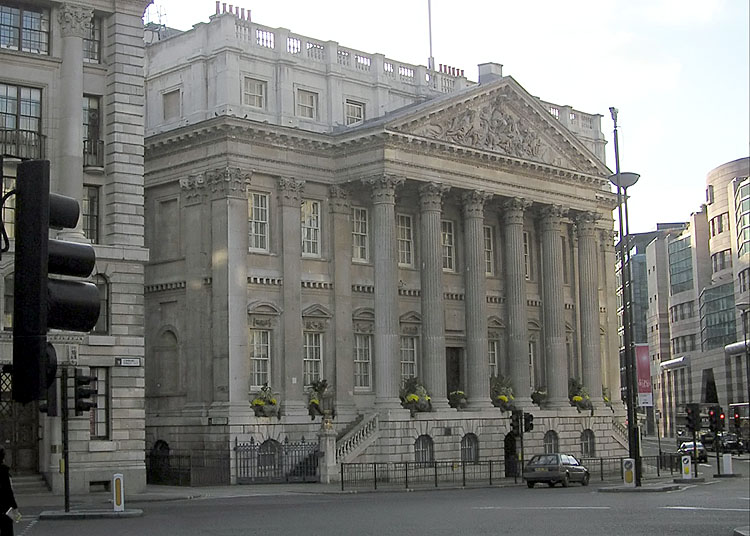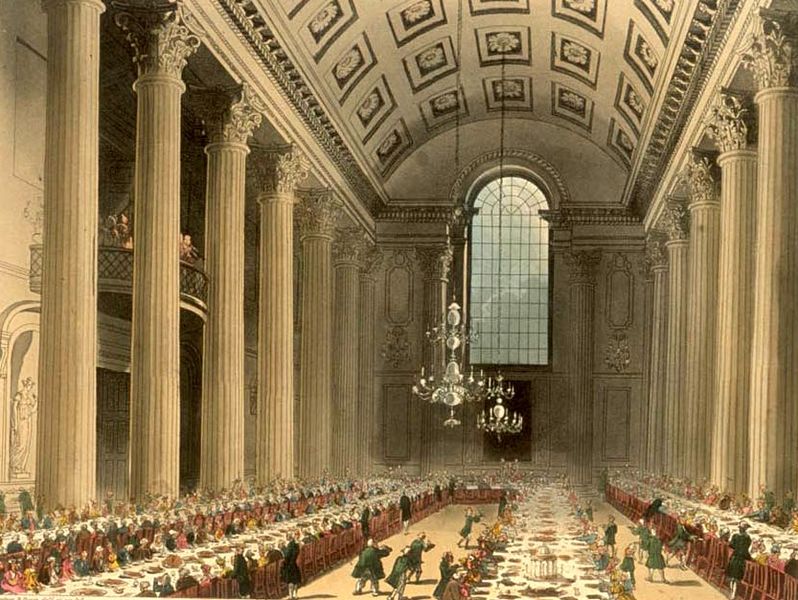Visit Reports
Mansion House Tour March 2011
Since 1752 all Lord Mayors of London have been able to use this imposing Georgian town palace as home and office. It was built to reflect
the importance of the City of London and provide state rooms suitable for hosting ceremonial occasions in grand style.
On arrival, we were welcomed by John Davies, the Principal Assistant, who became our guide for the morning. We went up the staircase to
the first floor and reached the beautiful reception area, known as The Saloon, with its sparkling chandeliers dating from1875; red and gold
carpet, and crimson and gold velvet thrones.

The Long Parlour, used for meetings and small dinners, is to the right of The Saloon and the two State Drawing Rooms to the left. These are a
mirror image pair of rooms with superb ivory and gold plasterwork ceilings and more lovely chandeliers, this time in a waterfall design. They
were furnished with 24 chairs and 3 sofas, known as the Nile Suite as they arrived in the Mansion House in 1803, 5 years after Lord Nelson’s
victory at the Battle of the Nile. They are a fascinating design with lions’ heads and paws on the arms and upturned anchors on the back. Finally,
the Egyptian Room, the most spectacular of all with its vast barrel vaulted ceiling in blue, gold and cream which was complemented by the carpet’s
laurel and stylised flowers in the same colours. This is where State banquets and receptions, of which we sometimes get a glimpse on TV, are held.

The morning tour ended with an extra treat when the Gold and Silver Vaults were opened up for us to view the extensive and priceless collection.
The earliest pieces preceded the Great Fire; many had been presented by former Lord Mayors at the end of their year of office and there were many
exceptional gifts, such as the model golden Arabian palace complete with palm trees and sand, presented by King Abdullah of Saudi Arabia on a
state visit in 2007.
During our lunch break, most of us spent some time in St Stephen Walbrook Church, located right next door to the Mansion House. It has a remarkable
dome, based on Wren’s original design for St Paul’s and these days is a church in the round since the arrival of Henry Moore’s white polished stone,
round altar.
In the afternoon two City of London guides gave us an insight into the17th century Dutch Masters displayed along the staircases and in the State Rooms,
which we had not had time to study in the morning. These paintings were bequeathed by Lord Harold Samuel of Wych Cross in 1987. There are some wonderful
paintings in the collection, including The Merry Lute Player by Frans Hals; four village scenes by Jan Brueghel; some superb still lifes; domestic
interiors and river and seascapes. My particular favourite was named Cattle by the River by Aelbert Cuyp. It made such a difference to have expert
guides able to draw our attention to the finer details and moral influences, with their enthusiasm and humour.
I think we all felt we had been very fortunate to have had this special experience and it was a day to be long cherished in the memory.
We hope to be able to repeat it next year for those who were disappointed to miss this visit.
Carole Sugden March 2011
